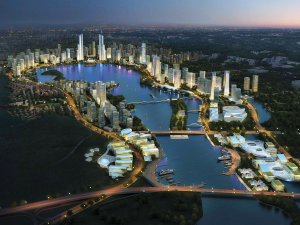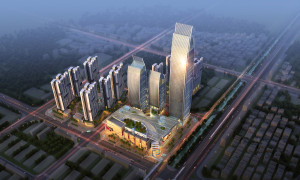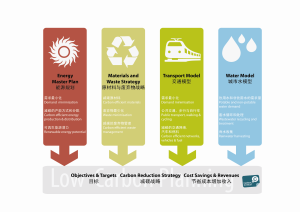China’s drive towards sustainable development is inspiring some innovative urban planning solutions. Due to its relatively late industrialisation it has the opportunity to develop its new cities while learning from mistakes made in the West. Mark Harrison, Sector Director for Urban Planning and Consultancy for Atkins in Asia Pacific, says that their experience in creating sustainable environments is helping to provide a guiding hand to China’s rapid urbanisation process.
 China’s rapidly growing built environment is inspiring urban planners to develop new ways of thinking, as it is increasingly recognised that a crucial underpinning for economic development in China is ensuring that continued rapid urbanisation is sustainable.
China’s rapidly growing built environment is inspiring urban planners to develop new ways of thinking, as it is increasingly recognised that a crucial underpinning for economic development in China is ensuring that continued rapid urbanisation is sustainable.
Environmental and sustainability considerations are now beginning to be incorporated into new city or town planning from the earliest stages, as opposed to introducing measures to reduce environmental damage after construction, which was the case in many European cities.
This was because Europe industrialised early, when the environmental impact of the built environment was sometimes not properly considered. This means that China’s developing cities have the advantage of learning from Europe’s mistakes. As climate change becomes more of a problem, it is increasingly important to consider factors like traffic, energy use, water use and how to deal with waste in new cities right from the beginning.
Atkins has recently won an important new commission to develop guidance for eco-low carbon (ELC) urban planning in China. Funded by the UK’s Foreign and Commonwealth Office Prosperity Fund, and led by Atkins’ sustainable planning team in Beijing, the project involves working closely with both national government agencies and city governments. It is aimed at providing a key, high-profile reference point for ELC urban planning in China. The Prosperity Fund brings together Chinese and British experts to develop low carbon policies, practices and regulations, with a growing focus on sustainable urbanisation.
China’s emerging ELC urbanisation initiative forms a key component of the government’s 12th Five-Year Plan, which places a strong emphasis on energy and resource efficiency, reducing green house gas (GHG) emissions and environmental protection.
To date the emphasis has been more on developing demonstration areas, ELC technologies and, more recently, establishing sustainable planning evaluation frameworks. With the vast scale and scope of urbanisation in China, there is a once-in-a-generation opportunity to build knowledge and experience of ELC urban planning approaches and methodologies. The project will work closely in partnership with local government in China to help achieve these aims.
Mark Hewlett, Atkins’ project manager, explains, “The project, which is closely aligned with Atkins’ Future Proofing Cities initiative, will provide a clear, practical methodology for ELC urban planning which sets out approaches, methods, tools and techniques tailored for Chinese local government planning based on international best practice.”
The project is designed to help support the gradual ‘mainstreaming’ of ELC urban planning in China as a vital foundation for sustainable urbanisation.
Supported by China’s Ministry of Housing and Urban-Rural Development, which has responsibility for green building and urban planning administration, the project team will work closely with two selected city governments to develop, test and apply the ELC guidance. The guidance will be designed to be closely integrated with China’s statutory urban planning requirements, and cross-referenced to current ELC urban planning indicator systems. The project outputs will be strongly focused on hands-on use as an everyday working tool in a practical, on-the-ground urban planning setting.
Whereas in the West where urban design is often concerned with the public realm and detailed design solutions, in China the focus is much more on overarching land use patterns, road networks and development densities. To create great places and spaces for people, and make development more environmentally friendly and sustainable, urban designers in China are applying fresh thinking and innovative solutions to meet some unique challenges.
While building densities and plot ratios are often very high by Western standards, traditional urban design involving large block sizes, road widths and set-backs, separation of residential and employment areas, and large areas of under-used open space have tended to encourage inefficient development and environmental deterioration as well as reduce liveability.
Attention is now increasingly turning to more compact, mixed-use and transit-oriented development approaches which emphasise ‘human scale’ design, community-oriented facilities and harmony with the natural environment, while ensuring the solutions are closely adapted to China’s highly distinct and diverse local context.
Apart from new construction projects, Atkins is heavily involved in many regeneration projects to help cities cope with a growing urban population and give them a new look. We recently provided guidelines on the regeneration work for Chengdu, capital of Sichuan province, a city known for its relaxed lifestyle but which has been transformed in recent years as a result of its fast-growing, high-tech industries.
Features of the regeneration included increasing greenery and building more low-speed roads in the city centre; adding central islands to pedestrian crossings to ensure safety; adding more leisure facilities such as shops and restaurants around big community parks; and increasing the use of green materials for important public-sector buildings.
 The key is to identify the real character of the area. Chengdu has many lively areas, especially its markets. It also has many natural landscape features, like river courses. It is important to make sure they are retained and not destroyed. Thus regeneration is about identifying and building on the character of a city to make it more liveable.
The key is to identify the real character of the area. Chengdu has many lively areas, especially its markets. It also has many natural landscape features, like river courses. It is important to make sure they are retained and not destroyed. Thus regeneration is about identifying and building on the character of a city to make it more liveable.
One clear advantage Atkins has in the field of regeneration is its engineering expertise in brownfield development. As the official engineering design services provider to the London Olympics last year, we demonstrated our brownfield site regeneration expertise by turning an old industrial site into a vibrant, safe sports venue. This expertise is extremely relevant and necessary in China, because many of the areas China is regenerating may previously have been used by factories that created pollutants.
Key to our innovative, sustainable urban planning approach is effectively linking land use planning, building and infrastructure design in the early stages of a project, with smart technology rapidly emerging as an important integration enabler. This approach increasingly informs all our work in China.
Future Proofing Cities Report
Atkins partnered with the UK Department for International Development (DFID) and University College London (UCL) to publish a report called Future Proofing Cities, which assesses the risks to 129 cities – from mega cities like Bangkok to smaller cities such as Zaria in Africa. It looks at their risk profile from climate hazards, resource scarcities, and damage to ecosystems and urges action now to future proof against these risks.
This report provides a fresh approach to the urgent issues arising from rapid urbanisation. It assesses the environmental risks facing cities in an integrated way and identifies more than 100 practical policy options that are most relevant and will be of most benefit to the different types of cities.
Atkins is one of the world’s leading design, engineering and project management consultancies, employing some 17,700 people across the UK, North America, Middle East, Asia Pacific and Europe. Over 75 years, from post-war regeneration and the advent of nuclear engineering to high speed rail and the integrated sustainable cities of the future, our people’s breadth and depth of expertise and drive to ask why has allowed us to plan, design and enable some of the world’s most complex projects.



Recent Comments